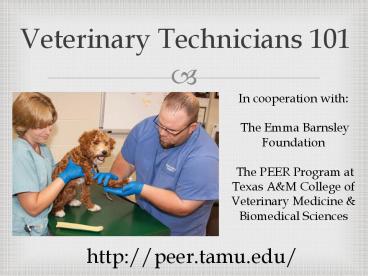Veterinary Technicians 101 PowerPoint PPT Presentation
1 / 19
Title: Veterinary Technicians 101
1
Veterinary Technicians 101
In cooperation with The Emma Barnsley
Foundation The PEER Program at Texas AM
College of Veterinary Medicine Biomedical
Sciences
http//peer.tamu.edu/
2
A Career Worth Barking About
3
Who We Are
- Veterinary technicians work under the supervision
of a licensed veterinarian to treat or to help
veterinarians diagnose the illnesses and injuries
of animals.
4
What We Do
- Obtain and record patient case histories
- Collect specimens and perform laboratory
procedures - Provide specialized nursing care
- Prepare animals, instruments, and equipment for
surgery - Assist in diagnostic, medical, and surgical
procedures - Expose and develop x-rays
- Supervise and train practice personnel
- Stock and maintain medicines and supplies
5
Education Requirements
- 2 year associates degree in veterinary
technology - 191 veterinary technology programs accredited by
the American Veterinary Medical Association - Veterinary Technician National Exam
- Licensed Veterinary Technician
- Texas State Regulatory Examination
- Registered Veterinary Technician
6
Career Outlook
- Employment expected to grow 52 by the end of the
decade - In the top 10 of growing occupations in the
country - Increased demand to support public health, food
animal safety, national disease control programs,
and biomedical research
7
The Career Field
Food Safety
Small and large animal clinics
Disaster and emergency response
Research and laboratory settings
Animal shelters or rescue organizations
Educational setting
Exotic and zoo animals
8
Specialization
- Anesthesia
- Surgical
- Internal medicine
- Dental
- Emergency and critical care
- Behavior
- Zoo
- Equine
- Clinical practice
- Nutrition
9
A Day In The Life of a Radiation Therapist
- Examine machines to ensure they are safe and
working properly - Explain treatment plans to clients and answer
questions - Follow safety procedures to protect the patient
and myself from overexposure - Check the computer programs to ensure the correct
dose of radiation is given to the correct area of
the patient's body
10
Radiation Therapist
- Operate the equipment to treat patient with
radiation - Monitor the patient to check for unusual
reactions to the treatment - Keep detailed records of treatment
11
Computed Tomography (CT)
- Use daily CT imaging to guide treatment based on
patient anatomy for that day - Surround the target with highly-precise radiation
delivered from all angles - Minimize radiation exposure to healthy tissue
- Adapt the treatment plan at any point
12
Tomo Therapy
- Unique design allows treatments to be delivered
continuously, from all angles around the patient - More beam directions give physicians more
control in planning treatments - Dose is better confined to the tumor, reducing
the risk of short- and long-term side effects
13
A Day In The Life of a Feline Internal Medicine
Technician
- Assist with appointments
- Patient Advocate
- Nursing Care
- Teach veterinary students
- Endoscopy
14
Feline Internal Medicine Technician
- Sample Collection
- Venipuncture
- Cystocentesis
- Assist in Procedures
- Feeding Tubes
- Joint Taps
- Abdominocentesis
- Thoracocentesis
15
Patient Care
16
Canine Blood Donors
- Blood shortages impact animal hospitals
- Texas AM Veterinary Medicine Teaching Hospital
houses a blood bank - Donor pets help keep a steady supply of blood and
blood components on hand for emergencies
17
Questions
18
Be sure to visit the PEER Program website for
videos and lessons!
http//peer.tamu.edu/
19
Thank you!
- Brought to you by
- The Emma Barnsley Foundation
- The PEER Program at
- Texas AM College of Veterinary Medicine
Biomedical Sciences

